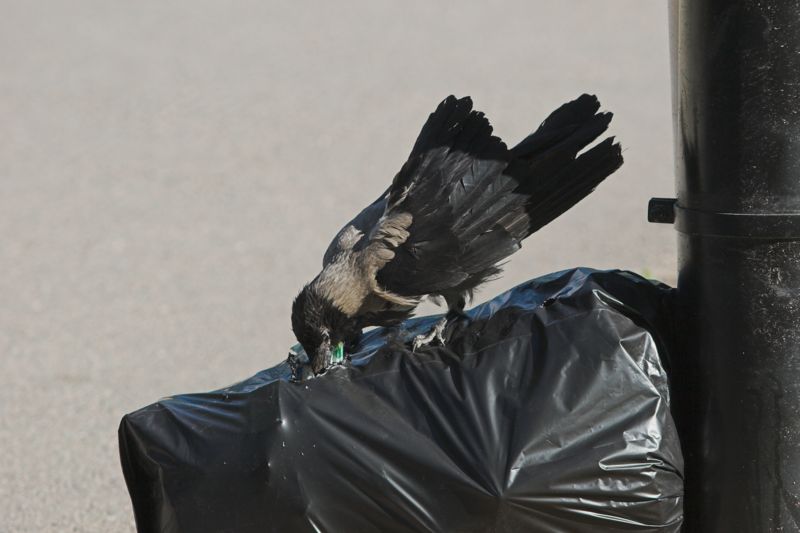|
| Query: white-necked crow | Result: 2nd of 4 | |
Crow (Family: Corvidae, Genus: Corvus) - Wiki
| Subject: | Crow (Family: Corvidae, Genus: Corvus) - Wiki
| |

| Resolution: 800x533
File Size: 46702 Bytes
Upload Date: 2007:12:02 20:19:04
|
Crow
From Wikipedia, the free encyclopedia
Scientific classification
Kingdom: Animalia
Phylum: Chordata
Class: Aves
Order: Passeriformes
Family: Corvidae
Genus: Corvus
[Photo] Hooded Crow (Corvus cornix) searching food from wastebag. Date: 20 July 2006. Photo by Thermos.
The true crows are large passerine birds that comprise the genus Corvus. Ranging in size from the relatively small pigeon-sized jackdaws (Eurasian and Daurian) to the Common Raven of the Holarctic region and Thick-billed Raven of the highlands of Ethiopia, the 40 or so members of this genus occur on all temperate continents (except South America) and several offshore and oceanic islands (including Hawaii).
In some widely spoken language it is also called 'Kak' as well as 'Kaua'.In literary and fanciful usage, the collective noun for a group of crows is a "murder." Groups of ravens have historically been called an "unkindness." However, in practice, most people use the more generic term flock, and sometimes more macabre terms such as "swarm" or "horde."
Systematics
The genus was originally described by Linnaeus in his 18th century work Systema Naturae. The name is derived from the Latin corvus meaning "raven". The type species is the Common Raven (Corvus corax); others named in the same work include the Carrion Crow (Corvus corone), the Hooded Crow (Corvus cornix), the Rook (Corvus frugilegus), and the Jackdaw (Corvus monedula).
There is no good systematic approach to the genus at present. Generally, it is assumed that the species from a geographical area are more closely related to each other than to other lineages, but this is not necessarily correct. For example, while the Carrion/Collared/House Crow complex is certainly closely related to each other, the situation is not at all clear regarding the Australian/Melanesian species. Furthermore, as many species are similar in appearance, determining actual range and characteristics can be very difficult, such as in Australia where the five (possibly six) species are almost identical in appearance.
The fossil record of crows is rather dense in Europe, but the relationships among most prehistoric species is not clear. Jackdaw-, crow- and raven-sized forms seem to have existed since long ago and crows were regularly hunted by humans up to the Iron Age, documenting the evolution of the modern taxa. American crows are not as well-documented.
A surprisingly high number of species have become extinct after human colonization; the loss of one prehistoric Caribbean crow could also have been related to the last ice age's climate changes.
Species
Australian and Melanesian species
Australian Raven Corvus coronoides
Forest Raven Corvus tasmanicus
- Relict Raven Corvus (t.) boreus
Little Crow Corvus bennetti
Little Raven Corvus mellori
Torresian Crow Corvus orru
New Caledonian Crow Corvus moneduloides
Long-billed Crow Corvus validus
White-billed Crow Corvus woodfordi
Bougainville Crow Corvus meeki
Brown-headed Crow Corvus fuscicapillus
Grey Crow Corvus tristis
New Ireland Crow, Corvus sp. (prehistoric)
New Zealand species
Chatham Islands Raven, Corvus moriorum (prehistoric)
New Zealand Raven, Corvus antipodum (prehistoric)
Pacific island species
Mariana Crow, Corvus kubaryi
Hawaiian Crow or ‘Alala Corvus hawaiiensis (extinct in the wild, formerly Corvus tropicus)
High-billed Crow, Corvus impluviatus (prehistoric)
Robust Crow, Corvus viriosus (prehistoric)
Tropical Asian species
Slender-billed Crow Corvus enca
Piping Crow Corvus typicus
Banggai Crow Corvus unicolor (possibly extinct)
Flores Crow Corvus florensis
Collared Crow Corvus torquatus
Daurian Jackdaw Corvus dauricus
House Crow Corvus splendens
Large-billed Crow Corvus macrorhynchos
- Jungle Crow Corvus (m.) levaillantii
Eurasian and North African species
Brown-necked Raven Corvus ruficollis
Somali Crow or Dwarf Raven Corvus edithae
Fan-tailed Raven Corvus rhipidurus
Jackdaw Corvus monedula
Rook Corvus frugilegus
Hooded Crow Corvus cornix
- Mesopotamian Crow, Corvus (c.) capellanus
Carrion Crow Corvus corone
- Carrion Crow (Eastern subspecies) Corvus (c.) orientalis
Corvus larteti (fossil: Late Miocene of France, or C Europe?)
Corvus pliocaenus (fossil: Late Pliocene ???? Early Pleistocene of SW Europe)
Corvus antecorax (fossil: Late Pliocene/Early ??? Late Pleistocene of Europe; may be subspecies of Corvus corax
Corvus betfianus (fossil)
Corvus praecorax (fossil)
Corvus simionescui (fossil)
Corvus fossilis (fossil)
Corvus moravicus (fossil)
Corvus hungaricus (fossil)
Holarctic species
Common Raven Corvus corax (see also next section)
- Pied Raven, Corvus corax varius morpha leucophaeus (an extinct color variant)
North and Central American species
American Crow Corvus brachyrhynchos
Western Raven Corvus (corax) sinuatus
Chihuahuan Raven Corvus cryptoleucus
Fish Crow Corvus ossifragus
Northwestern Crow Corvus caurinus
Tamaulipas Crow Corvus imparatus
Sinaloan Crow Corvus sinaloae
Jamaican Crow Corvus jamaicensis
White-necked Crow Corvus leucognaphalus
Palm Crow Corvus palmarum
Cuban Crow Corvus nasicus
Puerto Rican Crow Corvus pumilis (prehistoric; possibly a subspecies of Corvus nasicus/palmarum)
Corvus galushai (fossil: Big Sandy Late Miocene of Wickieup, USA)
Corvus neomexicanus (fossil: Late Pleistocene of Dry Cave, USA)
Tropical African species
Cape Crow Corvus capensis
Pied Crow Corvus albus
Somali Crow or Dwarf Raven Corvus edithae
Thick-billed Raven Corvus crassirostris
White-necked Raven Corvus albicollis
In addition to the prehistoric forms listed above, some extinct chronosubspecies have been described. These are featured under the respective species accounts.
...
http://en.wikipedia.org/wiki/Crow
| The text in this page is based on the copyrighted Wikipedia article shown in above URL. It is used under the GNU Free Documentation License. You may redistribute it, verbatim or modified, providing that you comply with the terms of the GFDL. |
|
^o^
Animal Pictures Archive for smart phones
^o^
|
|